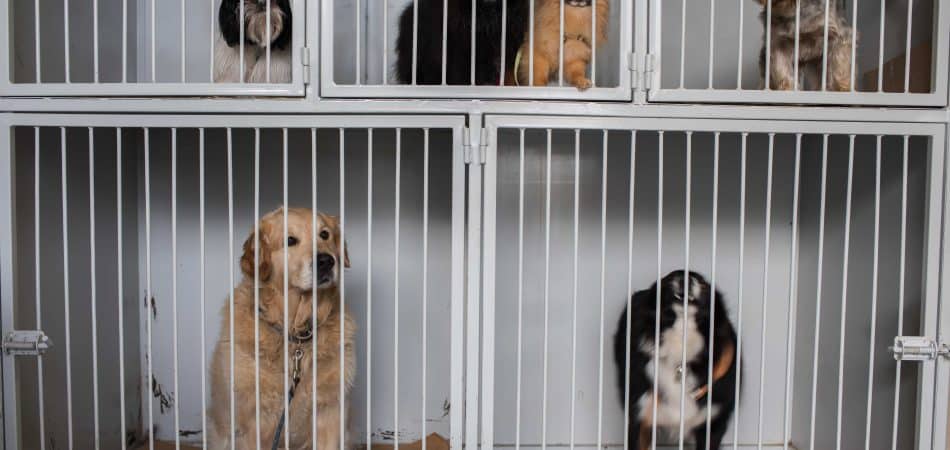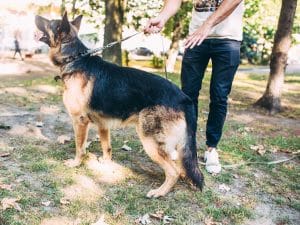






Let me just say this out of the way—getting a well-bred protection dog is hard. Not impossible. But hard. And the idea floating around that any breeder with a few titled dogs and some flashy Instagram clips can produce elite protection dogs? That’s risky.
Look…
You don’t breed for hype. You breed for temperament and stability. For nerve strength. For clarity of drive. Because when it comes to protection work, watered-down genetics and backyard pairings don’t just fall short—they create dangerous outcomes.
In my experience, the most dangerous dogs aren’t the ones with sky-high drive. It’s the unstable ones. The ones with nervous energy and conflicting instincts. The ones that look the part but don’t have the foundation to back it up.
You want the real deal?
Then you need a breeder who understands the whole picture—from bloodlines to behavioral imprinting, from environmental exposure to developmental timing.
You need someone who protects the process, not just sells the product.
The foundation of a true protection dog isn’t built in training—it’s built in breeding. In genetics, science, and early imprinting. And if that foundation is shaky? No amount of obedience, drills, or corrections will fix what was never solid to begin with.
That’s when things go wrong. That’s when you see headlines about dogs attacking and killing without warning. Because some breeders are chasing aggression, not stability, others are fixated on looks, pumping out litters that appear impressive but lack the traits that actually matter in protection work.
The truth is, you can’t manufacture nerve strength or clarity of drive later on. You can only build the right dog from the ground up.
And it all starts with one critical factor:
 Breeds exist for a reason. Border Collies herd. Greyhounds chase. German Shepherds guard. Those instincts aren’t trained—they’re inherited.
Breeds exist for a reason. Border Collies herd. Greyhounds chase. German Shepherds guard. Those instincts aren’t trained—they’re inherited.
A 2021 study of 101 breeds confirmed what top breeders have known all along: behavioral traits are highly heritable. Researchers identified 131 genetic variants that influence behaviors like territorial aggression, prey drive, and stress response.
Let that sink in: behavior isn’t random. It’s encoded.
As Noah Snyder-Mackler, co-author of the study, put it, dogs are a “good model for understanding what portion of behavior is written in their genes versus shaped by experience.”
The conclusion? Most breed diversity has come from one thing—selecting for behavior and purpose. James Serpell, a senior researcher in the study, said it best: “Selection has been primarily for behaviors—hunting, guarding, companionship.”
So, complex traits like temperament, work, and prey drive are governed by genes. You can’t fake that. You can’t wish it into existence. You can’t out-train poor breeding. Which is why top breeders don’t pair two “good dogs” and hope for the best
They select. They study. They test. Because they know—genetics set the ceiling.
The next variable is:
The second pillar a reputable breeder stands on.
Too many breeders skip this part or try to smooth it over with vague assurances. But if a dog isn’t structurally sound or genetically healthy, it won’t matter how stable its temperament is.
Protection dogs need durability. Longevity. Physical and mental soundness that holds up under pressure.
And as you already know, most working breeds are prone to a few health challenges. That’s why reputable breeders prioritize comprehensive health testing.
Which brings us to:
The Big Three: OFA, PennHIP, and CERF
OFA (Orthopedic Foundation for Animals)
Most known for screening hip dysplasia, OFA has become the gold standard in certifying a dog’s joint health. And while stiffness might not seem like a big deal at first, it can progress into chronic pain and even immobility.
Reputable breeders won’t just say, “Yeah, the parents are fine.” They’ll back it up with OFA-certified documentation—ideally two generations deep. You can verify it yourself at www.ofa.org.
PennHIP (Pennsylvania Hip Improvement Program)
This program goes even deeper—literally. It measures hip joint laxity, which helps predict the likelihood of degenerative joint disease before symptoms show up. It’s a more data-driven tool, and responsible breeders often use it alongside OFA to double down on certainty.
CERF (Canine Eye Registry Foundation)
Here’s one most casual buyers miss. CERF tracks heritable eye diseases certified by veterinary ophthalmologists. Why does that matter?
Well, a dog with failing vision can’t read your signals. Can’t target cleanly. Can’t stay confident in low-light environments.
And remember—CERF certifications only last one year. Breeders worth your trust will annually test, keep that updated, and have proof ready to show. You can double-check them at www.vmdb.org/cerf.html.
Pro-Tip:
“My vet says the dog is healthy,” and other stories aren’t proof. If a breeder can’t show paperwork, walk away. Health isn’t something you take on faith—it’s something you verify.
Between 3 and 12 weeks, a puppy’s brain is wiring itself for how it’ll interpret the world. Safe vs. dangerous. Playful vs. threatening. Trustworthy vs. unpredictable.
If a breeder mishandles this window—or ignores it entirely, they’re leaving that dog vulnerable to fear-based reactions later in life. So what does good development look like?
It’s in the textures underfoot. The sounds overhead. The feel of human touch. The surprise of a new object. It’s in how the pup learns to navigate frustration, recover from stress, and build confidence in unfamiliar places.
All the stuff that prepares a dog for pressure starts here—a psychological foundation that lasts a lifetime.
You don’t find elite breeders on Craigslist. Or by googling “protection dog for sale.” You vet them.
How?

These are your most honest reviews.
Health certifications for hips, elbows, and genetic conditions. Temperament testing results. Videos of how they guide early development and introduce pups to new challenges. Profiles built to match the right dog with the right home—not just make a quick sale.
You should be able to see it, read it, verify it—and talk to real people who’ve been through the process. If a breeder gets cagey, vague, or defensive? Walk. Fast.
If that’s not feasible, set up a live virtual walk-through. Look closely at the environment. Is it clean? Well-structured? Are the puppies curious and confident—or overly timid and overstimulated? Are they engaging with humans, or keeping their distance?
The physical setup should mirror everything the breeder told you. If it doesn’t, trust your gut.
Most buyers overlook this part. But it’s arguably the most important.
The best breeders screen you just as much as you screen them. They don’t just hand out dogs—they match them.
They ask about your home, your goals, and your handling experience. Because putting the wrong dog in the wrong hands is reckless—and they know it.
Any ethical breeder will turn down a sale if the fit isn’t right. They’ll pull a dog from a program if it doesn’t meet the standard. They don’t chase profit. They protect outcomes.
So, a breeder who treats this like a casual transaction is a red flag.
Contracts should be airtight, not vague one-pagers or generic templates. You’re looking for clearly defined terms of ownership, liability, and return policy. A health guarantee in writing. And often, a clause that gives the breeder the right to reclaim the dog if it’s ever at risk.
Top breeders don’t vanish once the dog leaves their hands. They check in. Offer follow-up support. Share training resources. And they care how the dog is doing months—or even years—down the line. If their support ends at the sale, so does their credibility.
Always—and I mean always—start with a breeder who protects the process from start to finish.
Registration is the first layer of protection. It tells you the breeder operates within a framework of professionalism, accountability, and recognized standards.
For protection and working dogs, the most reputable registries include:
Once you get the name, verify it. Don’t take their word for it. Most major organizations have online databases where you can look up the kennel name or breeder ID.
You should also ask for registration papers tied to specific dogs. Legit breeders will provide copies of the sire and dam’s registration certificates, and—if the litter is already registered—preliminary papers for the puppy. Again, these should match the official database records.
Just remember—registration is a baseline, not a badge of excellence. A registered breeder can still turn out unstable dogs if they cut corners.

But responsible breeders fall somewhere in between. They typically charge around $200 for a small breed, $300–$500 for a medium breed, $500–$1,000 for a large breed, and anywhere from $1,000 to $5,000 for a working breed puppy.
That price isn’t random—it reflects the actual investment made before the litter is even born.
First, there’s the cost of selecting and preparing the parents. This includes health screenings, genetic testing, temperament evaluations, and certifications—none of which come cheap. Only top-tier dogs make it into a responsible breeding program.
Then come the prenatal and postnatal expenses. Health testing doesn’t stop with the parents—puppies are monitored from birth, assessed for temperament, and tested for early signs of genetic issues.
Proper vet care includes vaccinations, deworming, and flea/tick prevention. And if a pup develops any complications—ear infections, minor injuries, or allergic reactions—those costs add up fast.
Nutrition is another major factor. Add grooming, enrichment toys, early training tools, proper housing, and specialized equipment—and you’re looking at thousands in overhead before a single pup goes home.
So when you see a $3,000 or $4,000 price tag, understand what you’re paying for: a well-bred, well-raised, genetically sound, and behaviorally stable dog from someone who has invested heavily in its first weeks of life.
Despite their low profit margins, good breeders are highly selective. They don’t hand over dogs to the first person who shows up with cash.
They have clear expectations, require detailed applications, and often stay involved for years after the sale. Because responsible breeders aren’t just selling dogs—they’re placing lives.
At Vanguard Protection Dogs, we only recommend breeders we know and trust—people we’ve vetted ourselves, and in some cases, partnered with directly.
If you’re starting with a puppy, we’ll guide you toward the right fit: responsible, ethical breeders who prioritize health, stability, and early development. And once that pup’s home? We’re the team to shape it into a world-class protection dog.
Prefer to skip the puppy phase altogether? You can also choose from our fully trained protection dogs—ready to integrate into your home, your family, your life.